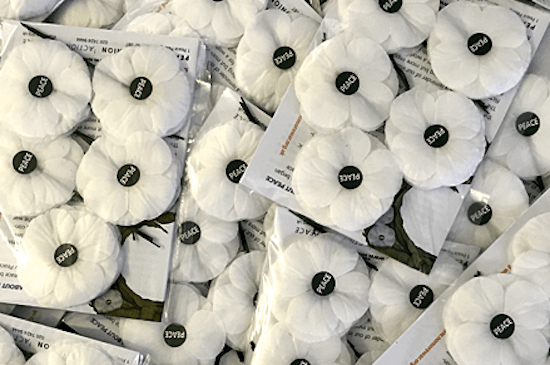What Does the Poppy Mean?
The History of the Poppy
During the First World War (1914–1918) much of the fighting took place in Western Europe. Previously beautiful countryside was blasted, bombed and fought over, again and again. The landscape swiftly turned to fields of mud: bleak and barren scenes where little or nothing could grow.
Bright red Flanders poppies (Papaver rhoeas) however, were delicate but resilient flowers and grew in their thousands, flourishing even in the middle of chaos and destruction. In early May 1915, shortly after losing a friend in Ypres, a Canadian doctor, Lt Col John McCrae was inspired by the sight of poppies to write a now famous poem called ‘In Flanders Fields‘.

McCrae’s poem inspired an American academic, Moina Michael, to make and sell red silk poppies which were brought to England by a French woman, Anna Guérin. The (Royal) British Legion, formed in 1921, ordered 9 million of these poppies and sold them on 11th November that year. The poppies sold out almost immediately and that first ever ‘Poppy Appeal’ raised over £106,000; a considerable amount of money at the time. This was used to help WW1 veterans with employment and housing.
The following year, Major George Howson set up the Poppy Factory to employ disabled ex-Servicemen. Today, the factory and the Legion’s warehouse in Aylesford produce millions of poppies each year.
The demand for poppies in England was so high that few were reaching Scotland. Earl Haig’s wife established the ‘Lady Haig Poppy Factory’ in Edinburgh in 1926 to produce poppies exclusively for Scotland. Over 5 million Scottish poppies (which have four petals and no leaf unlike poppies in the rest of the UK) are still made by hand by disabled ex-Servicemen at Lady Haig’s Poppy Factory each year.
The Symbol of the Poppy
The poppy is:
- A symbol of Remembrance and hope
- Worn by millions of people
- Red because of the natural colour of field poppies.
The poppy is NOT:
- A symbol of death or a sign of support for war
- A reflection of politics or religion
- Red to reflect the colour of blood.
Wearing a poppy is a personal choice and reflects individual and personal memories. It’s compulsory but is greatly appreciated by those it helps – the beneficiaries: those currently serving in our Armed Forces, veterans, and their families and dependants.
What About The White Poppy?
The White Poppy was first introduced by the Women’s Co-operative Guild in 1933 and was intended as a lasting symbol for peace and an end to all wars.
Worn on Armistice Day, now Remembrance Sunday, the White Poppy was produced by the Co-operative Wholesale Society because the Royal British Legion had refused to be associated with its manufacture.
While the White Poppy was never intended to offend the memory of those who died in the Great War, many veterans felt that its significance undermined their contribution and the lasting meaning of the red poppy. Such was the seriousness of this issue that some women lost their jobs in the 1930s for wearing white poppies. The White Poppy Appeal is now run by the Peace Pledge Union.
So We Wear Poppies …
… to remember those who have given their lives in battle is because they are the flowers which grew on the battlefields after World War One ended.
Why is Ronimix Supporting Remembrance Day …
… Many of our staff and colleges had family who fought in the First and Second World Wars and some currently have family in the armed forces.
You may also like to read about The Concrete Ears and Poem by McCrea

